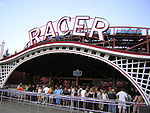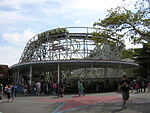Braddock Locks & Dam
1906 establishments in PennsylvaniaDams completed in 1906Dams in PennsylvaniaMonongahela RiverUnited States Army Corps of Engineers, Pittsburgh District ... and 2 more
United States Army Corps of Engineers damsWater transportation in Pennsylvania

Braddock Locks & Dam (previously named Monongahela Locks and Dam No. 2) is one of nine navigational structures on the Monongahela River between Pittsburgh, Pennsylvania and Fairmont, West Virginia. Built and maintained by the U.S. Army Corps of Engineers, the gated dam and the lock form an upstream pool that is for 12.6 miles (20.3 km), stretching to Elizabeth, Pennsylvania.
Excerpt from the Wikipedia article Braddock Locks & Dam (License: CC BY-SA 3.0, Authors, Images).Braddock Locks & Dam
Great Allegheny Passage,
Geographical coordinates (GPS) Address Nearby Places Show on map
Geographical coordinates (GPS)
| Latitude | Longitude |
|---|---|
| N 40.390833333333 ° | E -79.857777777778 ° |
Address
Ladle Shed
Great Allegheny Passage
15104
Pennsylvania, United States
Open on Google Maps











